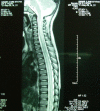Spinal epidural abscess with myelitis and meningitis caused by Streptococcus pneumoniae in a young child
- PMID: 21756576
- PMCID: PMC3127372
- DOI: 10.1179/107902610x12883422813507
Spinal epidural abscess with myelitis and meningitis caused by Streptococcus pneumoniae in a young child
Abstract
Background: Spinal epidural abscess (SEA) in children is a rare infectious emergency warranting prompt intervention. Predisposing factors include immunosuppression, spinal procedures, and local site infections such as vertebral osteomyelitis and paraspinal abscess. Staphylococcus aureus is the most common isolate.
Design: Case report and literature review.
Findings: A 2.5-year-old boy with tetraparesis was found to have an SEA in the posterior lumbar epidural space with evidence of meningitis and myelitis on MRI spine in the absence of any local or systemic predisposing factors or spinal procedures. Streptococcus pneumoniae was isolated from the evacuated pus.
Conclusions: Definitive treatment of SEA is a combination of surgical decompression and iv antibiotics. Timely management limits the extent of neurological deficit.
Figures



Similar articles
-
Spinal epidural abscess and meningitis following short-term epidural catheterisation for postoperative analgaesia.BMJ Case Rep. 2015 Aug 20;2015:bcr2015210867. doi: 10.1136/bcr-2015-210867. BMJ Case Rep. 2015. PMID: 26294360 Free PMC article.
-
[Case of spinal epidural abscess with wide lesion after epidural anesthesia].Brain Nerve. 2009 May;61(5):614-5. Brain Nerve. 2009. PMID: 19514524 Japanese. No abstract available.
-
[Diagnostic methods in spinal infections].Radiologe. 2001 Nov;41(11):976-86. doi: 10.1007/s001170170034. Radiologe. 2001. PMID: 11765539 Review. German.
-
Rare cause of back pain: Staphylococcus aureus vertebral osteomyelitis complicated by recurrent epidural abscess and severe sepsis.BMJ Case Rep. 2016 Dec 13;2016:bcr2016217111. doi: 10.1136/bcr-2016-217111. BMJ Case Rep. 2016. PMID: 27965310 Free PMC article.
-
[Syrinx formation secondary to cervical epidural abscess].Rinsho Shinkeigaku. 2007 Feb-Mar;47(2-3):90-5. Rinsho Shinkeigaku. 2007. PMID: 17511275 Review. Japanese.
Cited by
-
Healthy adults with Streptococcus pneumoniae meningitis and Streptococcus pneumoniae subdural abscess: two case reports and a literature review.J Int Med Res. 2022 Nov;50(11):3000605221137470. doi: 10.1177/03000605221137470. J Int Med Res. 2022. PMID: 36396983 Free PMC article. Review.
-
Spinal and paraspinal pneumococcal infections-a review.Eur J Clin Microbiol Infect Dis. 2014 Apr;33(4):517-27. doi: 10.1007/s10096-013-1997-3. Epub 2014 Jan 31. Eur J Clin Microbiol Infect Dis. 2014. PMID: 24481748 Review.
-
Spinal epidural abscess and meningitis following short-term epidural catheterisation for postoperative analgaesia.BMJ Case Rep. 2015 Aug 20;2015:bcr2015210867. doi: 10.1136/bcr-2015-210867. BMJ Case Rep. 2015. PMID: 26294360 Free PMC article.
-
A case on streptococcal pneumonia associated with leptomeningitis, osteomyelitis and epidural abscess in a patient with AIDS.Tuberc Respir Dis (Seoul). 2014 Feb;76(2):80-3. doi: 10.4046/trd.2014.76.2.80. Epub 2014 Feb 27. Tuberc Respir Dis (Seoul). 2014. PMID: 24624217 Free PMC article.
References
-
- Enberg RN, Kaplan RJ. Spinal epidural abscess in children: early diagnosis and immediate surgical drainage is essential to forestall paralysis. Clin Pediatr 1974;13(3):247–53 - PubMed
-
- Auletta JJ, John CC. Spinal epidural abscesses in children: a 15-year experience and review of the literature. Clin Infect Dis 2001;32(1):9–16 - PubMed
-
- Darouiche RO. Spinal epidural abscess. N Engl J Med 2006;355(19):2012–20 - PubMed
-
- Akalan N, Ozgen T. Infection as a cause of spinal cord compression: a review at 36 spinal epidural abscess cases. Acta Neurochir (Wien) 2000;142(1):17–21 - PubMed
-
- Phillips JMG, Stedeford JC, Hartsilver E, Roberts C. Epidural abscess complicating insertion of epidural catheters. Br J Anaesth 2002;89(5):778–82 - PubMed
Publication types
MeSH terms
LinkOut - more resources
Full Text Sources
Medical
